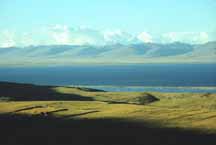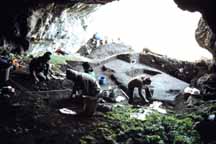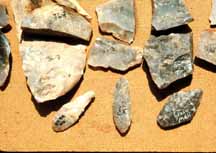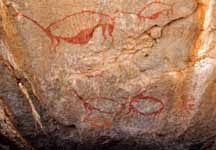
This web site is intended to serve as an introduction to the archaeology of some preceramic societies of the high altitude grass-lands of the Peruvian Andes that make up the "puna" zone. There is evidence of humans here beginning possibly 12,000 years ago and the preceramic time frame covers the years until 1800 BC. This age can be divided around 9000 BC by the ending of an early glacial period. This is a particularly interesting area to study because it deals with the earliest known human inhabitance of this sierra environment in the Andes.
 The harsh climate and
lands
of this ecological zone forced adaptations that had a huge impact on how these societies developed. The focus here will be on smaller groups that relied mostly on hunting and gathering. Although chronology is important, the approach here will deal more with the aspects of highland life in the Andes that would present the greatest challenges, and how the people adapted to maximize certain limited. All of the slides, charts, and
maps
, as well as the research behind this presentation, are those of Professor John Rick from Stanford University.
The harsh climate and
lands
of this ecological zone forced adaptations that had a huge impact on how these societies developed. The focus here will be on smaller groups that relied mostly on hunting and gathering. Although chronology is important, the approach here will deal more with the aspects of highland life in the Andes that would present the greatest challenges, and how the people adapted to maximize certain limited. All of the slides, charts, and
maps
, as well as the research behind this presentation, are those of Professor John Rick from Stanford University.
 It is possible to accurately theorize a significant amount about these prehistoric people just by considering how limitations of the highland environment would force adaptations. However, without archaeological
excavations
and scientific interpretation of the data gathered, an enormous amount of details would be impossible to discover using general observatory methods. Key resources can usually be identified with confidence by examining the artifacts uncovered with excavations. In the highland Andean plains, the remains indicate that
camelids
were an extremely important resource, especially vicuna. It is very interesting how the evidence can provide information beyond just the amount which people used vicuna and other available resources.
It is possible to accurately theorize a significant amount about these prehistoric people just by considering how limitations of the highland environment would force adaptations. However, without archaeological
excavations
and scientific interpretation of the data gathered, an enormous amount of details would be impossible to discover using general observatory methods. Key resources can usually be identified with confidence by examining the artifacts uncovered with excavations. In the highland Andean plains, the remains indicate that
camelids
were an extremely important resource, especially vicuna. It is very interesting how the evidence can provide information beyond just the amount which people used vicuna and other available resources.
 From the preceramic age, chipped stone tools are the only artifacts that can be found uniformly preserved and distributed in the Andes. There are two main types of stone tools cut at this time, one is for
basic tool use,
and the other cut especially for hunting as
projectile points
. These tools are an excellent source of information because they can reliably tell archaeologists what their primary use was. Stone tools can indicate some of the needs of the people and the ability they had to create devices to fill these needs.
From the preceramic age, chipped stone tools are the only artifacts that can be found uniformly preserved and distributed in the Andes. There are two main types of stone tools cut at this time, one is for
basic tool use,
and the other cut especially for hunting as
projectile points
. These tools are an excellent source of information because they can reliably tell archaeologists what their primary use was. Stone tools can indicate some of the needs of the people and the ability they had to create devices to fill these needs.
 The final area of archaeology that will be dealt with in this presentation is
art
. Ancient art is difficult to interpret because it does not necessarily show what the people were doing at the time. Rock paintings may portray
Certain images however, clearly depict aspects of life that the ancient people were likely to encounter and do provide information about what they probably experienced. Another place to look for pieces of ancient artistry is in
burials
. The preceramic people discussed here were mostly from egalitarian groups and there was little differentiation among people in their burials. Whether in abundance or not, art does serve as an indirect way to learn about these societies.
Basically, this presentation aims to show the variety of ways in which information can be gathered, and how it can be interpreted to really learn something about how people lived thousands of years ago in a harsh environment high in the Andes.
The final area of archaeology that will be dealt with in this presentation is
art
. Ancient art is difficult to interpret because it does not necessarily show what the people were doing at the time. Rock paintings may portray
Certain images however, clearly depict aspects of life that the ancient people were likely to encounter and do provide information about what they probably experienced. Another place to look for pieces of ancient artistry is in
burials
. The preceramic people discussed here were mostly from egalitarian groups and there was little differentiation among people in their burials. Whether in abundance or not, art does serve as an indirect way to learn about these societies.
Basically, this presentation aims to show the variety of ways in which information can be gathered, and how it can be interpreted to really learn something about how people lived thousands of years ago in a harsh environment high in the Andes.
This page also contains photographic
panoramas
of preceramic sites. To view these you will need the RealSpace plug-in.
Click here
to obtain this free plug-in.
| 



